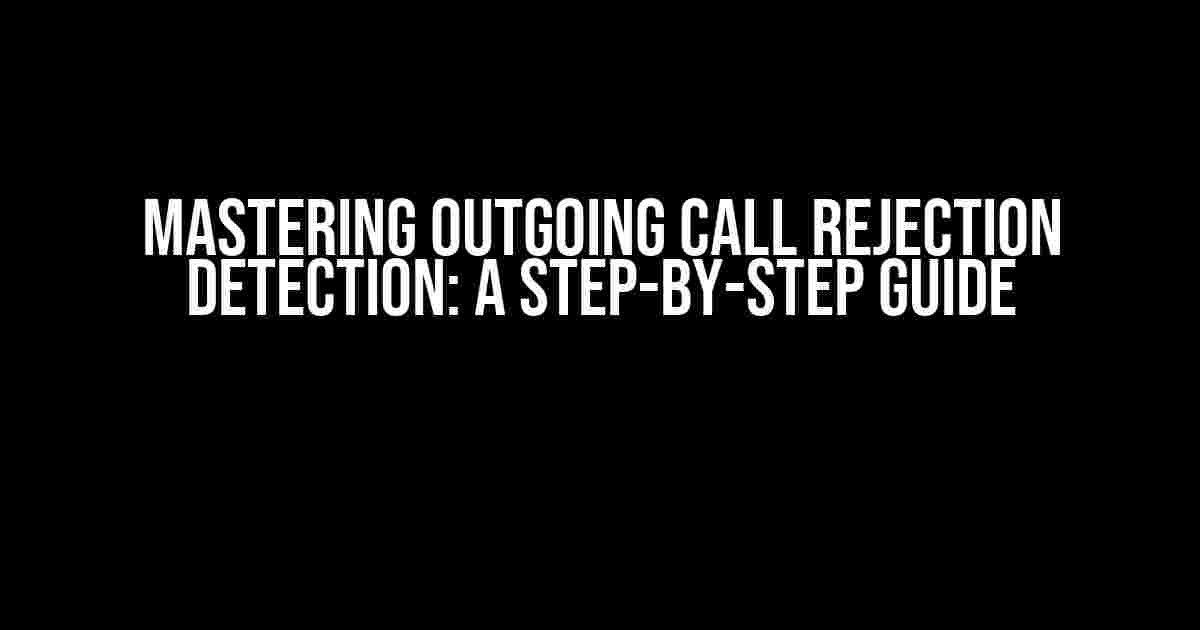Are you tired of dealing with frustrated customers due to unexpected call rejections? Do you struggle to identify the root cause of the issue, only to find yourself stuck in a cycle of trial and error? Look no further! In this comprehensive guide, we’ll delve into the world of outgoing call rejection detection, providing you with the knowledge and tools necessary to tackle this common yet pesky problem.
What is Outgoing Call Rejection Detection?
Outgoing call rejection detection refers to the process of identifying and addressing the reasons behind rejected outbound calls. This can occur due to various factors, such as incorrect phone numbers, busy lines, or network congestion. By implementing an effective detection system, you can minimize call rejection rates, improve customer satisfaction, and increase the efficiency of your sales or customer service teams.
Why is Outgoing Call Rejection Detection Important?
- Enhanced Customer Experience: By detecting and resolving call rejection issues, you can ensure that customers receive timely and efficient service, leading to increased satisfaction and loyalty.
- Improved Sales Productivity: Minimizing call rejections enables sales teams to focus on converting leads, resulting in higher conversion rates and revenue growth.
- Reduced Operational Costs: Identifying and addressing the root causes of call rejections can help reduce the need for additional resources, such as personnel or infrastructure.
Outgoing Call Rejection Detection Methods
There are several approaches to detecting outgoing call rejections, each with its strengths and weaknesses. We’ll explore the most common methods, providing you with a solid understanding of how to implement each one.
1. Traditional Methods
Traditional methods involve manual call monitoring and analysis. This can be time-consuming and prone to human error, but it provides a basic understanding of call rejection patterns.
// Example of manual call monitoring script
import csv
with open('calls.csv', 'r') as file:
reader = csv.reader(file)
for row in reader:
if row[1] == 'rejected':
print("Call to", row[0], "was rejected")
2. IVR (Interactive Voice Response) Integration
IVR systems can be integrated with your call center infrastructure to detect and analyze call rejections. This method provides more accurate data and automates the detection process.
| IVR Feature | Description |
|---|---|
| Call Back | Automatically calls back customers whose calls were rejected |
| Call Forwarding | Forwards rejected calls to available agents or queues |
| Real-time Analytics | Provides detailed insights into call rejection patterns and trends |
3. API-Based Detection
API-based detection involves integrating your call center system with third-party APIs that specialize in call rejection detection. This method offers advanced analytics and real-time monitoring.
// Example of API-based detection using Python
import requests
api_key = "YOUR_API_KEY"
call_data = {"phone_number": "+1234567890", "call_status": "rejected"}
response = requests.post(f"https://api.example.com/detect_rejection",
headers={"Authorization": f"Bearer {api_key}"},
json=call_data)
if response.status_code == 200:
print("Call rejection detected!")
Best Practices for Outgoing Call Rejection Detection
To get the most out of your outgoing call rejection detection system, follow these best practices:
- Regularly Update Your Caller Lists: Ensure that your caller lists are up-to-date and accurate to minimize incorrect phone numbers and busy lines.
- Monitor Call Quality: Regularly monitor call quality to identify potential issues that may lead to call rejections.
- Analyze Rejection Patterns: Analyze call rejection patterns to identify trends and areas for improvement.
- Implement Real-time Alerts: Set up real-time alerts to notify your team of call rejection incidents, enabling swift action to resolve the issue.
- Train Your Agents: Train your agents to handle call rejections professionally and efficiently, ensuring a positive customer experience.
Conclusion
Outgoing call rejection detection is a crucial aspect of maintaining a efficient and customer-centric call center operation. By understanding the causes of call rejections and implementing effective detection methods, you can minimize rejection rates, improve customer satisfaction, and increase sales productivity. Remember to stay vigilant, regularly update your systems, and train your agents to handle call rejections with ease.
With the knowledge and tools provided in this guide, you’re well on your way to mastering outgoing call rejection detection and taking your call center to the next level!
Happy detecting!
Frequently Asked Question
Learn more about Outgoing Call Rejection Detection and how it can benefit your business!
What is Outgoing Call Rejection Detection?
Outgoing Call Rejection Detection is a feature that identifies and prevents outgoing calls from being rejected by a recipient’s phone or network. This innovative technology helps businesses optimize their outbound calling campaigns, reducing the risk of calls being blocked or marked as spam.
Why is Outgoing Call Rejection Detection important for businesses?
Outgoing Call Rejection Detection is crucial for businesses as it helps maintain a positive brand reputation, ensures compliance with regulations, and improves the overall customer experience. By detecting and preventing call rejections, businesses can avoid being flagged as spammers, reduce the likelihood of calls being blocked, and increase the chances of successful connections with customers.
How does Outgoing Call Rejection Detection work?
Outgoing Call Rejection Detection uses advanced algorithms and real-time analytics to identify patterns and anomalies in call rejections. This technology can detectipient phone or network rejections, such as “number not reachable” or “call barred,” and automatically adjust the calling strategy to minimize rejections and maximize connections.
Can Outgoing Call Rejection Detection be integrated with existing call center software?
Yes, Outgoing Call Rejection Detection can be seamlessly integrated with most call center software and platforms. This integration enables businesses to leverage the power of this technology without disrupting their existing operations or infrastructure.
Is Outgoing Call Rejection Detection a compliance requirement?
While Outgoing Call Rejection Detection is not a direct compliance requirement, it helps businesses comply with regulatory guidelines, such as the Telephone Consumer Protection Act (TCPA), by reducing the risk of calls being marked as spam or blocked. This technology is essential for maintaining compliance and avoiding potential fines and penalties.

